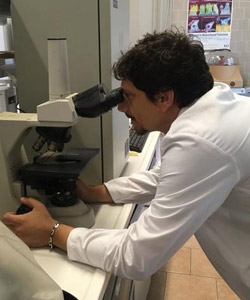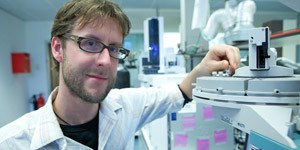By Viola Brugnatelli

Viola Brugnatelli is a neuroscientist and endocannabinologist, she carries out research and teaching on cannabis at the Dept. Of Neuroscience, University of Padua, Italy, and is the co-founder of
Cannabiscienza, an education company for healthcare professionals on the endocannabinoid system and medical cannabis.
A long standing member of the International Cannabinoid Research Society, and Italian Ambassador for the International Association for Cannabis Medicine, Viola's background is in pharmacology labs, specialising in orphan cannabinoid/terpenoid receptors and their signalling in pain and inflammation.
Currently she collaborates with Fundación Canna, the Journal of Cannabinoid Medicine editorial board, and as a guest author for a series of magazines in the field, including Project CBD. Viola
over the years contributed to several CME courses on cannabis, educating MDs and pharmacists worldwide. She is the VP of a non-for-profit that aims to empower women working with plant medicine.
What fascinates her most about the cannabis plant is what we can learn and understand about the endocannabinoid system and how to modulate it in different ways beyond phytocannabinoids. Lately she has been closely working with anaesthesiologists who operate with hypnotherapy to
evaluate the role of the ECS in the ability of altering our states of consciousness without drugs.
Meet the Experts is a series of interviews conducted by experts from the field of Cannabis to world leaders in research and clinical practice of Cannabis as medicine.

Livio Luongo (1979) is an Associate Professor of Pharmacology at the University of Campania "Luigi Vanvitelli" with over 100 publications and an award by prestigious Universal Scientific Education and Research Network (USERN) prize.
His research interest revolves around the involvement of the endocannabinoid system in the pathophysiology of the chronic/degenerative neuroinflammatory diseases, neuron-glia communication and new pharmacological tools that can target them.
During the course of 2019 and 2020 his group, together with the research group lead by Chemistry Professor Giuseppe Cannazza, at the University of Modena and Reggio Emilia, identified and isolated 6 new phytocannabinoids, namely THCP, CBDP, THCB, CBDB, THCH and CBDH. For those discoveries, an Italian cannabis variety, the FM2, has been used. In the interview he shares what working on this field has taught him so far.
Viola Brugnatelli: How did you start working on cannabinoids?
Livio Luongo: I have been working in the chronic pain field since starting my PhD in Pharmacology in 2006. At that time my supervisor Prof. Sabatino Maione, nowadays director of the Pharmacology Unit of the Department of Experimental Medicine, University of Campania "L. Vanvitelli", was collaborating with Dr. Vincenzo Di Marzo for investigating new endogenous molecules belonging to the endocannabinoid system. Therefore, I was involved in the cannabinoid field at the beginning of my career.
VB: What is your contribution in the cannabis field?
LL: As I just mentioned, I have been working more on the endocannabinoids rather than cannabis-derived compounds at the beginning of my PhD.
We worked on the CB2 and TRPV1 receptors highlighting their potential role in neuropathic pain, and in the sensorial and neuropsychiatric features of this debilitating disease. We have characterised, at least in part, the mechanism of action of palmitoylethanolamide (PEA) and other endocannabinoid-like compounds that are involved in the pathophysiology of chronic neuropathic pain.
In the last few years, however, I have also been investigating cannabis-derived compounds in models of chronic pain, traumatic brain injury and other neuropsychiatric diseases.
VB: What is your contribution in the discovery of the new minor cannabinoids recently identified?
LL: The new cannabinoids were isolated by the Research group headed by Professor Giuseppe Cannazza at University of Modena.
With my group, we have pharmacologically characterised those compounds in pain models and, particularly for the tetrahydrocannabiphorol (THCP), in the tetrad test, which represents a widely used test for screening drugs that induce cannabinoid receptor-mediated effects in rodents. Briefly, the four behavioural components of the tetrad are: 1) spontaneous activity, 2) catalepsy, 3) hypothermia and 4) analgesia. Through these behavioural evaluations we confirmed the in vitro data collected by the Cannazza's group. Interestingly, Tetrahydrocannabiphorol is much more potent than THC in exerting the tetrad behaviour and what we found is that by using the same concentration of THC, 10 mg/kg, we obtained a massive pharmacological effect, so we lowered the dosage and we got around 2 mg/kg, still obtaining tetrad behaviour.
With regards to the other compounds, we used a model of tonic pain induced by paw injection of formalin, which is characterised by two different pain-phases. The first one is an intense painful stimuli, followed by a chronic-like pain effect induced by formalin.
The injection of these compounds, in particular THCP, exerted a reduction of nocifensive pain that we obtained with the injection to the paws. This effect was mediated by both CB1 and CB2 receptors, because CB1 and CB2 receptors selective antagonists were able to abolish the effect of the compound. This is interesting and we need to investigate further for potential applications in neuropatic pain, which is kind of an untreatable pain so far.
However, the other compounds discovered by our colleagues and further characterised by our group, also deserve further investigation for their potential application in models of chronic pain, particularly neuropathic pain that is often refractory even to opioids.
These compounds are the butol analogs and eptylic analogs.
VB: What was the percentage concentration of these compounds in the cannabis variety you tested?
LL: These compounds had very low concentration in the chemovar tested. The concentration of CBD was about 15 mg x gram, THC was about 40 mg x gram, CBDB, the cannabidibutol, had a concentration around 0.4-5 mg x gram, so CBDB concentration was 100 times less compared to the concentration of CBD.
Same thing for THCP with a concentration of one hundredth of the concentration of THC, while the concentration of the corresponding butyl homolog (THCB) was about 150% less compared to the concentration of CBD and 100 times less than the concentration of THC.
Concentrations were hence very low in the FM2 cannabis variety.
Por tanto, en la variedad de cannabis FM2 las concentraciones eran muy bajas.
VB: Could we find these compounds also in other chemovars? Could it be possible to improve the genetics of other varieties to make them produce higher amounts of these compounds?
LL: Yes, of course it is possible to find higher and lower concentrations of these compounds in other cannabis varieties.
However, we don't know yet if these compounds are produced in the cannabis plant by an enzymatic way. We are keen to understand whether there is an enzyme that synthesises THCP, like THCA. If so, then it's possible to create, modify or select varieties that produce higher concentrations of THCP.
VB: You made a radio binding assay to test the affinity of these compounds to CB1 receptors and you found out that one of these compounds, namely the tetrahydrocannabiphorol (THCP) is 30 times more powerful than THC. From a pharmacological point of view, what do you think it means to have such a powerful cannabinoid?
LL: We can think about the yin and yang effect of this compound. If we want to talk about pharmacological effects in terms of possible pharmacotherapeutic effect of this compound, we can suppose that using a very low dosage, imagine a micro-dose, similarly to the now-trending field of psycogenic compounds like LSD, psylocibin and so on, could exert beneficial effects without generating side effects.
On the other hand, for the recreational use of cannabis this could pose a risk. Image if we have this type of THCP-rich variety, and someone smokes a joint of it, several problems can emerge.
Overstimulating CB1 receptors can create issues. The problem is that most cannabinoids have biphasic effects, showing, for example, anxiolytic effects at low doses and anxiogenic when increasing the dose, which is the possible outcome also with tetrahydrocannabiphorol.
VB: Why discovering cannabis-compounds is still important?
LL: On one hand these compounds indicate that several minor compounds could be isolated in cannabis with new technologies and dedicated research, on the other hand the identification of new molecules, although in very little amount, paves the way for investigating the potential pharmacological properties in preclinical models of several pathologies and later on in clinical trials. It is a step forward. When we find another compound, we can start to use this compound in several kind of models. Afterwords we can think of applications for specific human pathologies.
I also see this as an important step for helping us better title and ameliorate the process of standardization of medical varieties. Currently, the only two parameters of interest in cannabis are THC and CBD concentration, however in the plant we also have CBC, CBG, CBDV and so on.. However, we don't know their concentrations when we use Medical Cannabis, so we can also imagine that other compounds may be present in the plant with their specific mechanisms of action in terms of pharmacology, that could be used for different kind of pathologies as well.
VB: What are your plans for the future?
LL: What we discovered it's just a small portion of all cannabinoids or phytocannabinoids
that can be discovered. In fact, we suppose there should be corresponding cannabigerolic compounds, cannabichromenic compounds, cannabinoids with the butylic homolog, eptylic homolog, like for the varinoids, the propilic homolog that was already discovered in the past and so on... so there's a lot of work to do. I surely will go on with basic research, which is what I really like to do, even if funding for that is continuously lacking. As of recently, we are characterizing new chronic pain models, in particular we are interested in the vulvodynia neurobiology. This is because the biomolecular, morphofunctional and cellular pathways involved in this pathology are very poorly understood.
As a neuropathic pain neuropharmacologist, I personally think that vulvodynia needs to be better characterized in order to find molecular targets to pharmacologically modulate and better treat this debilitating disease that affect more than 16% of women.
Thank you professor Luongo for sharing this insights with us and we wish you all best for your important research activities.


